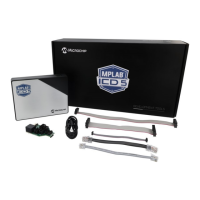Debugger Funcon Summary
User Guide
© 2023 Microchip Technology Inc. and its subsidiaries
DS-50003529B - 80
Table 9-10. Clock Opon Category
Use FRC in Debug mode
(dsPIC33E/F and PIC24E/F/H devices only)
When debugging, use the device fast internal RC (FRC) for
clocking instead of the oscillator specied for the application.
This is useful when the application clock is slow.
Checking this checkbox will let the application run at the slow
speed but debug at the faster FRC speed.
Reprogram after changing this setting.
Note: Peripherals that are not frozen will operate at the FRC
speed while debugging.
Target run-time instruction speed Enter a value for the “Speed unit” selected.
Example 1: For a PIC24 MCU and a target clock oscillator at
32 MHz (HS), instruction speed = 32 MHz/2 = 16 MIPS.
Example 2: For a PIC18F8722 MCU and a target clock
oscillator at 10 MHz (HS) making use of the PLL (x4 = 40 MHz),
instruction speed = 40 MHz/4 = 10 MIPS.
Instruction speed units Select either:
KIPS – Thousands (10
3
) of instructions per second
MIPS – Millions (10
6
) of instructions per second
9.2.9 Communicaon
Set the option(s) to use for your device and type of target communication.
Table 9-11. Communicaon Opon Category
Interface Select the interface from the available options based on the project device.
Speed (MHz) Enter a speed based on the available range for the interface.
High Voltage Activation Mode This option displays only for AVR
®
devices with this option. No High Voltage - Default
setting. Simple High Voltage Pulse - The tool will try to activate the interface
by issuing a high voltage pulse. This procedure is safe if the pin is congured as
an input. User Power Toggle - In this mode the user will be prompted to toggle
power on the target device. Once the tool detects that the power returns it will
issue a high voltage pulse before the target device pin is congured, making the
activation procedure as gentle as possible. See also UPDI High-Voltage Activation
Information.
9.2.9.1 User Power Toggle Design Consideraons
When using the debugger, if the power toggle rise time on Target Vdd is too slow (greater than 10
seconds) the User Power Toggle feature won't work. As an example, for the STK600 using the power
switch gives you a too slow rise time but using the VTARGET jumper gives you a fast enough rise
time.
For developers creating their own boards, ensure the Vdd rise time is less than 10 seconds.
9.2.9.2 Programming AVR Devices with UPDI
MPLAB ICD 5 supports using the high-voltage mechanism to activate the AVR Unied Program and
Debug Interface (UPDI). On low pin count AVR devices with UPDI, the UPDI pin can be congured
as GPIO or RESET by conguring the RSTPINCFG conguration bits. To do further programming, the
debugger will have to use a high voltage pulse to reactivate the UPDI interface. When using the high
voltage pulse, you must make sure that all circuits connected to the UPDI wire can tolerate a pulse of
at least 12V.
GPIO vs. UPDI Operation:
When using a high voltage pulse to reactivate the UPDI interface, the reactivation is only temporary,
but it will retain the UPDI functionality until the next reset. After the next reset, the pin will go back
to the conguration as specied by the RSTPINCFG conguration bits. To have the pin congured as
UPDI after a reset, the user will have to change the RSTPINCFG conguration bits back to UPDI.

